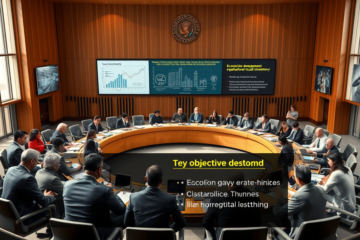Increase in Default in Agribusiness is Alarming
Default in agribusiness is a growing concern that deserves in-depth analysis.
In the second quarter of 2025, this ratio reached 7.02%, reflecting the impacts of adverse economic conditions and an increase in judicial recoveries following the 2024 crop failure. In this article, we will explore the factors that contributed to this alarming increase, the financial performance of the sector, and the measures the government is implementing to mitigate the effects of defaults, especially in the context of high interest rates and climate problems.
Additionally, we will discuss the real estate credit landscape and its implications.
Current Default in Brazilian Agribusiness
In the second quarter of 2025, the default in Brazilian agribusiness reached the worrying mark of 7,02%.
This increase reflects a combination of factors that put pressure on the sector's financial sustainability.
Among the elements that contributed to this condition, the following stand out: adverse economic conditions, exacerbated by high interest rates that remain at 15% per year.
The significant increase in judicial recoveries is also a key element in this scenario, especially after the crop failure that occurred in 2024. This resulted in additional challenges for farmers, who were already struggling to cope with economic volatility.
According to data, many producers who took out credit in times of lower Selic rate now face difficulties in honoring their debts in the current economic circumstances.
Furthermore, while a record harvest is expected in 2025, this recovery has not yet translated into immediate relief for producers' finances.
The government is trying to mitigate such risks through debt renegotiation measures, thus trying to offer some breathing space to those affected.
Financial Performance: Profit of R$1.6 Billion
In the second quarter of 2025, Brazilian agribusiness demonstrated its resilience when recording a profit of R$ 3.6 billion.
This value implies a growth of 12% compared to the same period of the previous year, standing out amid a challenging economic scenario.
Despite the significant increase in the default rate to 7.02%, a result of high interest rates and weather problems that affected crops, the sector managed to remain robust and profitable.
This positive financial performance is a reflection of the strategies adopted by companies to mitigate risks and maximize opportunities in a competitive market.
Furthermore, Brazilian agribusiness exports, which reached US$1.4 trillion in the first quarter of 2025, contributed to the strengthening of the sector.
The government, recognizing the importance of stability in agribusiness, implemented debt renegotiation measures to support affected producers, in addition to planning new fundraising models, as described in the Growing exports reflecting on agribusiness.
Credit Balance and New Hiring
The agribusiness sector recorded a financial balance of R$ 60.5 billion in the second quarter of 2025. The newly hired reached the amount of R$ 5.7 billion, reflecting robust performance despite economic challenges.
A capital injection provided by these new hires is vital for maintaining liquidity in the sector, which is facing a considerable increase in defaults.
| Indicator | Value |
|---|---|
| Total Balance | R$ 60.5 billion |
| New Hires | R$ 5.7 billion |
However, a slight slowdown in the pace of hiring is visible, impacted by high interest rates and adverse weather conditions.
This slowdown highlights the need for strategic actions to ensure financial sustainability, such as government renegotiation measures to support affected producers.
Maintaining a continuous flow of resources is essential to minimize the impacts of high default rates, ensuring that the sector continues to develop amid economic challenges.
For more details, visit the link to O Globo.
Main Factors of High Default Rate
The high default rate in agribusiness in 2025 can be attributed mainly to two critical factors.
The first factor is the rise in interest rates, which has reached a level of 15% per year.
This condition significantly increased the cost of credit, putting pressure on rural producers who depend on financing to maintain their operations.
Financial management in agribusiness 2025
Understand the current market scenario
The second factor is the severe weather events, such as the crop failure in 2024, which directly impacted agricultural productivity.
- Interest of 15% per year
- Severe weather events
The sum of these elements reduced the producers' ability to pay.
Many of them, already facing financial difficulties, were unable to honor their commitments, leading to a considerable increase in default rates.
Furthermore, abrupt changes in weather conditions challenged harvest predictability, affecting expected revenue.
Producers now need to deal with an adverse financial scenario, seeking alternatives to renegotiate debts and thus avoid legal action, as pointed out in Caixa report.
Adopting government measures to alleviate these pressures is essential to stabilize the sector and allow producers to resume economic growth.
Real Estate Credit Linked to Agribusiness
A growing default in real estate credit associated with agribusiness has attracted significant attention, especially with the slowdown in hiring, which currently reached **R$ 57.3 billion**.
This not only reflects the economic strain on the sector, but also highlights the fragility faced by many rural producers.
These producers, who rely heavily on this type of financing to expand and modernize their operations, now face an increasingly challenging financial environment.
Furthermore, adverse economic conditions and rising interest rates to a staggering 15% per year add pressure, limiting the ability to service old debts and incur new ones.
The impact of all this is evident in the difficulties faced in maintaining agricultural operations at competitive levels, resulting in an urgent need for effective government solutions.
Some of these are being highlighted by the government, which is proposing renegotiation measures to mitigate these concerns.
However, the sector is impatiently awaiting the development of these implementations, as the current environment is increasingly critical.
Government Measures and New Financing Models
Throughout the second quarter of 2025, an alarming increase in defaults in agribusiness was observed, rising to 7,02% due to adverse economic conditions and previous crop failures.
To mitigate these impacts, the government implements measures renegotiation with the aim of support affected producers.
These initiatives seek to offer more favorable payment terms in order to alleviate the financial pressure faced by many farmers.
In parallel, the announcement of new financial models aimed at the real estate credit sector, as part of a comprehensive strategy to revitalize the economy.
According to the Broadcast website, these models seek to make the use of savings resources more flexible, allowing banks to use them in more profitable operations, thus increasing their credit potential.
These changes aim not only to boost the real estate sector but also to create a more stable economic environment where families can confidently invest in new homes.
In this way, by addressing both urgent needs and long-term growth prospects, it is hoped to reduce defaults and promote economic recovery.
In summary, defaults in agribusiness and the real estate credit sector highlight the urgent need for support measures for producers.
Planned government actions can be crucial in helping to stabilize these affected areas.



0 Comments